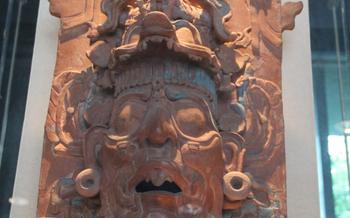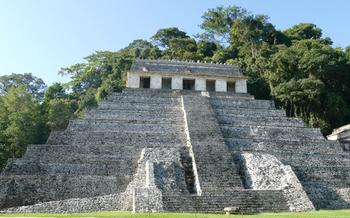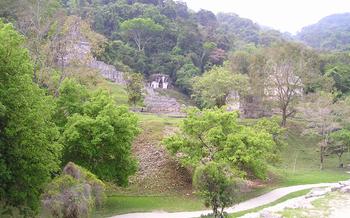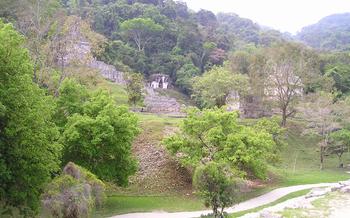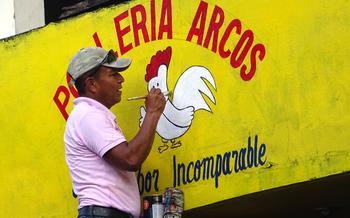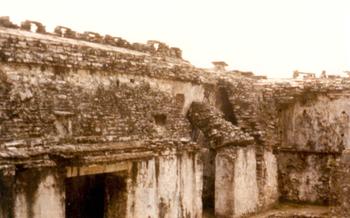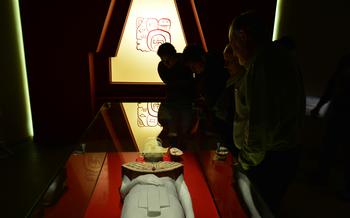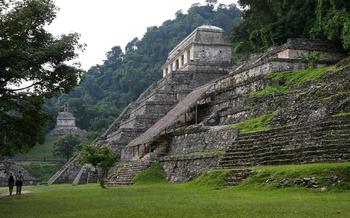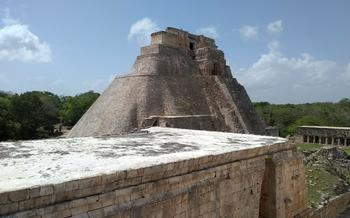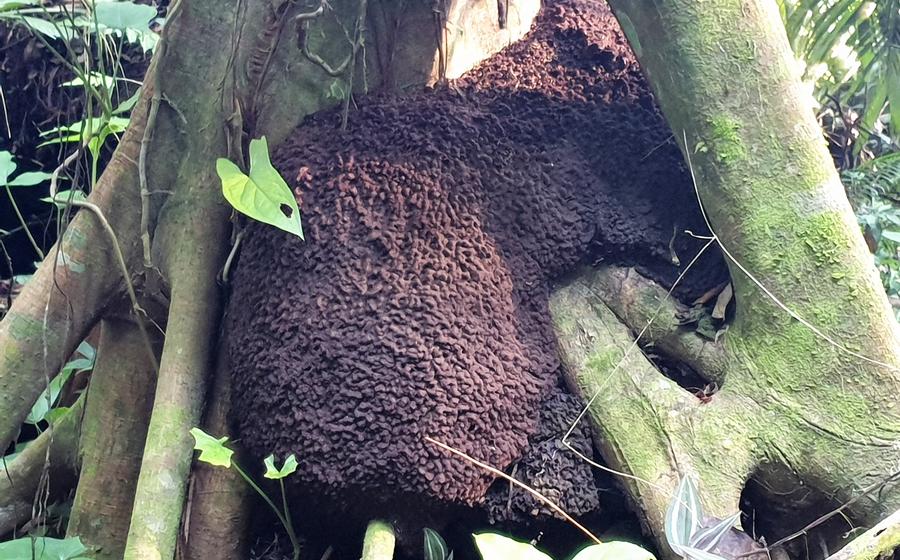
Zona Arqueológica Toniná
- Palenque: An Enchanting Destination
- Discovering Zona Arqueológica Toniná
- Step into the Past: Exploring the Ruins
- The Grand Acropolis: A Symbol of Power
- Plaza of the Sculptures: A Gallery of Stone Masterpieces
- Temple of the Inscriptions: Unveiling Royal Tombs
- Ball Court: A Realm of Ritual and Competition
- Museo de Sitio de Toniná: A Treasure Trove of Discoveries rich history and culture of the ancient Maya civilization at the Museo de Sitio de Toniná. This captivating museum houses a remarkable collection of artifacts and relics unearthed from the archaeological site, providing a unique glimpse into the lives and accomplishments of the Maya people.
- A Journey Through Time: Guided Tours and Experiences
- Transportation Options: Reaching the Archaeological Zone
- Accommodation and Dining Options: A Culinary and Cultural Journey
- Safety Tips for a Worry-Free Experience
Palenque: An Enchanting Destination
Nestled amidst the lush tropical rainforests of Chiapas, Mexico, lies the enchanting city of Palenque, a place steeped in ancient history, rich culture, and captivating natural beauty. Once a thriving metropolis of the Mayan civilization, Palenque boasts an array of well-preserved ruins, architectural wonders, and natural marvels that beckon travelers from around the world. As you wander through the verdant landscapes and explore the remnants of this once-great city, you'll be transported back in time, immersing yourself in the vibrant heritage of the Maya.
Among the must-see attractions in Palenque are the awe-inspiring ruins of the ancient city itself, where you can marvel at the intricate carvings and towering structures that stand as testaments to the ingenuity and craftsmanship of the Maya. The National Museum of Palenque houses a vast collection of artifacts and relics that provide a glimpse into the daily lives, beliefs, and rituals of the ancient Maya. For those seeking a more immersive experience, a visit to the nearby Agua Azul Waterfalls offers a chance to swim in crystal-clear turquoise waters and admire the stunning cascades that plunge into the lush jungle below.
Discovering Zona Arqueológica Toniná
**Zona Arqueológica Toniná ancient Maya city that stands as a testament to the ingenuity and cultural richness of this civilization. The site, nestled within the lush jungle canopies, boasts a unique history and architectural features that set it apart from other Maya cities.
Historical Context and Significance: Toniná's history dates back to the Late Classic period (600-900 AD), when it emerged as a powerful rival to the renowned city of Palenque. The city reached its peak during the 8th century, becoming the dominant force in the region. Its strategic location along trade routes and its control over key resources contributed to its rise to prominence.
Architectural Features and Unique Structures: The ruins of Toniná reveal a distinctive architectural style characterized by towering pyramids, elaborately carved stelae, and intricate sculptures. The city is home to the tallest structure in the Maya region, known as "El Mirador," which stands at an impressive height of over 70 meters. This remarkable pyramid showcases the advanced engineering skills of the Maya and offers breathtaking views of the surrounding jungle.
Importance in the Mayan Civilization: Toniná played a crucial role in the political and cultural landscape of the Maya civilization. It was a significant center of power and influence, engaging in alliances and rivalries with neighboring cities. The city's rulers were prolific builders and patrons of the arts, leaving behind a legacy of stunning architecture, sculptures, and ceramics that provide valuable insights into Maya culture and history.
Step into the Past: Exploring the Ruins
The layout of Zona Arqueológica Toniná showcases a sophisticated urban design, with plazas, temples, and palaces arranged around a central axis. The site features over 80 structures, including the impressive Acropolis, the Plaza of the Sculptures, and the Temple of the Inscriptions.
The Acropolis, the most prominent structure, rises majestically above the site. It comprises several levels, each adorned with intricate carvings and sculptures depicting significant historical events and rulers. The Temple of the Inscriptions, located at the base of the Acropolis, is renowned for its well-preserved inscriptions and the discovery of the tomb of King Pakal, one of the most important rulers of the Maya civilization.
Notably, the Plaza of the Sculptures houses an impressive collection of carved stone monuments, stelae, and altars. These sculptures depict various scenes from Maya mythology, history, and everyday life, offering valuable insights into the beliefs and customs of the ancient Maya. The ball court, with its sloped sides and stone markers, provides a glimpse into the significance of the ancient Mesoamerican ball game, which held both ritualistic and entertainment purposes.
The Grand Acropolis: A Symbol of Power
Within the sprawling expanse of Zona Arqueológica Toniná, the majestic Acropolis stands as a testament to the might and grandeur of the ancient Maya civilization. This colossal structure, towering over the surrounding landscape, commands attention and awe. Its intricate architectural features and imposing presence reflect the political and religious significance it held in the lives of the Maya people.
The Acropolis served as the nerve center of the ancient city, a place where rulers resided, important rituals were performed, and administrative decisions were made. Its design showcased advanced engineering techniques and artistic prowess, featuring multiple levels, terraces, and elaborate facades adorned with intricate carvings and sculptures.
One of the most striking aspects of the Acropolis is its sheer size. The massive platform upon which it rests stretches over several acres, providing ample space for temples, palaces, and other important structures. The steep staircases leading to the upper levels add to the imposing grandeur of the Acropolis, emphasizing its monumental scale.
The Acropolis was not merely a symbol of power but also a stage for significant historical events and the residence of powerful rulers. It is believed that some of the most prominent Maya kings, including K'inich Janaab' Pakal I and his son K'inich Kan B'alam II, ruled from this majestic edifice. Their reigns marked a period of prosperity, territorial expansion, and cultural flourishing for the city of Toniná.
The Acropolis played a central role in the religious life of the Maya. It housed several temples dedicated to various deities, including the sun god, the rain god, and the maize god. These temples were adorned with intricate carvings and sculptures depicting mythological scenes and important religious figures. The Acropolis was a place where the Maya performed elaborate rituals, sought divine guidance, and celebrated important religious festivals.
Exploring the Acropolis is a journey through time, allowing visitors to glimpse into the lives of the ancient Maya rulers, witness the grandeur of their architecture, and understand the profound religious significance of this sacred space.
Plaza of the Sculptures: A Gallery of Stone Masterpieces
Amidst the ruins of Toniná, the Plaza of the Sculptures stands as a testament to the artistic prowess and storytelling abilities of the ancient Maya. This open space is adorned with an array of intricately carved stone sculptures, each narrating tales of gods, rulers, and important events from the city's history.
The plaza is dominated by several large stelae, or carved stone slabs, which depict scenes of royal ceremonies, battles, and alliances. The stelae are adorned with intricate carvings that showcase the Maya's mastery of bas-relief, a technique in which figures and symbols are carved into the stone's surface, creating a three-dimensional effect.
Among the most notable sculptures in the plaza is a stela depicting a ruler named K'inich Yax K'uk' Mo', who is shown seated on a throne and holding a scepter. The stela also features a hieroglyphic text that provides valuable insights into the ruler's lineage and accomplishments.
Other sculptures in the plaza include representations of deities, such as the maize god and the rain god, as well as scenes of everyday life, such as hunting, fishing, and agriculture. The variety and artistic significance of the sculptures in the Plaza of the Sculptures make it a must-see attraction for visitors to Toniná.
The plaza was likely used for a variety of purposes, including religious ceremonies, political gatherings, and public announcements. The sculptures served as a visual reminder of the city's history, culture, and religious beliefs, and they continue to captivate visitors with their beauty and symbolism to this day.
Temple of the Inscriptions: Unveiling Royal Tombs
The Temple of the Inscriptions stands as a testament to the architectural prowess and cultural significance of the ancient Maya civilization. This iconic structure, situated at the heart of Zona Arqueológica Toniná, commands attention with its imposing pyramid-like form and intricate carvings that adorn its facade.
Dating back to the 7th century AD, the temple served as a mausoleum for King K'inich Janaab' Pakal, one of the most renowned rulers of the Maya city-state of Palenque. Its discovery in 1952 by Mexican archaeologist Alberto Ruz Lhuillier marked a pivotal moment in Maya archaeology, revealing a treasure trove of artifacts and shedding new light on the lives and beliefs of the ancient Maya.
The temple's most remarkable feature is the elaborately carved stone lintel above the entrance, depicting Pakal's journey to the underworld. The lintel portrays the king seated on a throne, surrounded by supernatural beings and symbols of Maya mythology. This intricate carving provides valuable insights into Maya cosmology and the importance of the afterlife in their culture.
Within the depths of the temple, Ruz Lhuillier unearthed Pakal's intact tomb, a rare and remarkable find in Maya archaeology. The tomb contained a wealth of funerary objects, including a massive stone sarcophagus adorned with intricate carvings. The discovery of Pakal's tomb and the artifacts within provided invaluable information about Maya burial practices and the significance of the Temple of the Inscriptions as a royal mausoleum.
Today, the Temple of the Inscriptions remains one of the most visited and studied structures at Zona Arqueológica Toniná. Its architectural grandeur, intricate carvings, and the discovery of Pakal's tomb have cemented its place as a symbol of Maya ingenuity and a window into the rich cultural heritage of this ancient civilization.
Ball Court: A Realm of Ritual and Competition
At the heart of Zona Arqueológica Toniná lies an impressive ball court, a testament to the significance of the ancient Mesoamerican ball game. This rectangular court, meticulously crafted with sloped sides and stone markers, played a central role in the lives of the Maya people.
The game, known as pok-ta-pok, was not merely a sport but a sacred ritual deeply intertwined with religious beliefs and social customs. It held profound symbolic and mythological meanings, often associated with fertility, warfare, and the struggle between good and evil.
Beyond its ritualistic nature, the ball game served as a form of entertainment and a means of conflict resolution. Communities engaged in friendly competitions, showcasing their athleticism and strategic skills. Victories brought honor and prestige to the winning team, while defeats were often seen as a sign of divine disapproval.
The ball court at Toniná stands as a silent witness to these ancient contests. Its well-preserved condition allows visitors to envision the intensity and drama of the games that once took place within its confines. The echoes of ancient cheers and the rhythmic bounce of the rubber ball seem to linger in the air, transporting visitors back in time to a world where sport, ritual, and community intertwined.
Museo de Sitio de Toniná: A Treasure Trove of Discoveries rich history and culture of the ancient Maya civilization at the Museo de Sitio de Toniná. This captivating museum houses a remarkable collection of artifacts and relics unearthed from the archaeological site, providing a unique glimpse into the lives and accomplishments of the Maya people.
Through interactive displays and educational programs, the museum brings to life the stories behind the artifacts, shedding light on the intricate social, political, and religious systems of the Maya. Visitors can admire intricate stone carvings, ceramic vessels, and jade ornaments, each piece offering a tangible connection to the past.
The museum also showcases scale models of the archaeological site, allowing visitors to visualize the grandeur and layout of the ancient city. These models provide a comprehensive understanding of the urban planning and architectural achievements of the Maya.
A visit to the Museo de Sitio de Toniná is an essential complement to exploring the archaeological zone, offering a deeper appreciation for the rich cultural heritage of the Maya civilization. It serves as a testament to the enduring legacy of this ancient people and their profound impact on the history and identity of Mexico.
A Journey Through Time: Guided Tours and Experiences
Exploring Zona Arqueológica Toniná with a knowledgeable guide is an enriching experience that enhances your understanding of the site's history and significance. Guided tours are available in various languages, ensuring that visitors from different backgrounds can delve into the wonders of this ancient city.
These tours offer a personalized experience, as guides tailor their explanations to the interests and questions of the group. They provide insights into the lives of the Maya, their customs, and the importance of Toniná in the Mayan civilization. Guided tours typically cover the major attractions of the site, including the Grand Acropolis, the Plaza of the Sculptures, the Temple of the Inscriptions, and the ball court.
In addition to standard guided tours, visitors can opt for specialized experiences such as birdwatching tours, photography workshops, or even night tours that offer a unique perspective on the archaeological zone. These specialized tours allow visitors to explore the site's natural surroundings, capture stunning images, or gain a deeper understanding of Mayan astronomy and rituals.
Whether you prefer a comprehensive overview or a focused exploration of specific aspects of Toniná, guided tours are an excellent way to make the most of your visit. They provide a deeper connection to the past and a lasting appreciation for the rich cultural heritage of the Maya.
Transportation Options: Reaching the Archaeological Zone
Reaching Zona Arqueológica Toniná from Palenque requires careful planning. Several transportation options are available, depending on your preferences and budget.
Public transportation is a convenient and affordable option. Regular buses depart from Palenque's bus station and take approximately two hours to reach the archaeological zone. The buses are comfortable and offer a scenic journey through the countryside.
For a more comfortable and personalized experience, consider renting a car. This option provides the freedom to explore the area at your own pace and visit other nearby attractions. Car rental agencies are available in Palenque, and the roads leading to the archaeological zone are well-maintained.
Organized tours are another popular option, especially for those who prefer a hassle-free experience. Many tour companies in Palenque offer day trips to Zona Arqueológica Toniná, often combined with visits to other nearby attractions. These tours typically include transportation, a guided tour of the ruins, and lunch.
Driving directions to Zona Arqueológica Toniná are straightforward. From Palenque, take Highway 199 south towards Ocosingo. After approximately 60 kilometers, turn left onto a well-marked road leading to the archaeological zone. Parking facilities are available on-site.
Accommodation and Dining Options: A Culinary and Cultural Journey
Palenque offers a diverse range of accommodation options to suit every traveler's budget and preference. From charming guesthouses and hostels to luxurious hotels, there's something for everyone. For a truly immersive experience, consider staying in one of the many hotels or guesthouses located within walking distance of the archaeological zone. This allows you to fully embrace the atmosphere of the ancient city and make the most of your time exploring its wonders.
When it comes to dining, Palenque's culinary scene is a delightful blend of traditional Mexican flavors and international cuisine. Savor the authentic taste of Mexico at local restaurants, where you can indulge in mouthwatering dishes such as cochinita pibil, enchiladas, and tamales. For a more diverse culinary experience, try one of the many international restaurants offering everything from Italian pasta to Thai curries.
Don't miss the opportunity to sample the local street food, which is a feast for both the taste buds and the eyes. From freshly made tacos and tortas to exotic tropical fruits, the street vendors offer a delicious and affordable way to experience the local flavors.
For those looking for a unique dining experience, consider visiting one of the many cenotes in the area. These natural swimming holes often have restaurants or cafes nearby, where you can enjoy a refreshing dip in the crystal-clear waters followed by a delicious meal.
Safety Tips for a Worry-Free Experience
Visiting Zona Arqueológica Toniná should be a pleasant and safe experience for all travelers. Here are some essential safety tips to keep in mind:
-
Be aware of your surroundings: Like any tourist destination, it's important to maintain situational awareness and be cautious of your belongings. Keep an eye on your valuables and avoid displaying them unnecessarily.
-
Respect cultural norms and customs: Mexico is a culturally rich country, and respecting local customs is essential. Dress appropriately, especially when visiting sacred or religious sites, and be mindful of local traditions.
-
Stay hydrated and protected from the sun: The tropical climate of Chiapas can be hot and humid, especially during the summer months. Bring plenty of water and wear sunscreen, sunglasses, and a hat to protect yourself from the sun's harsh rays.
-
Follow safety instructions: There may be specific safety guidelines and instructions posted at the archaeological site. Be sure to read and follow these instructions for your safety and the preservation of the ruins.
-
Be cautious during the rainy season: Chiapas experiences a rainy season from May to October. While the rain adds to the lushness of the natural surroundings, it can also make surfaces slippery and increase the risk of flooding. Exercise caution during this period.
By following these simple safety tips, you can ensure a safe and enjoyable visit to Zona Arqueológica Toniná.
